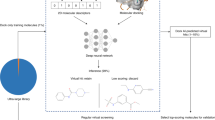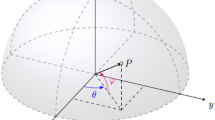Abstract
The previously reported procedure to generate “universal” Generative Topographic Maps (GTMs) of the drug-like chemical space is in practice a multi-task learning process, in which both operational GTM parameters (example: map grid size) and hyperparameters (key example: the molecular descriptor space to be used) are being chosen by an evolutionary process in order to fit/select “universal” GTM manifolds. After selection (a one-time task aimed at optimizing the compromise in terms of neighborhood behavior compliance, over a large pool of various biological targets), for any further use the manifolds are ready to provide “fit-free” predictive models. Using any structure–activity set—irrespectively whether the associated target served at map fitting stage or not—the generation or “coloring” a property landscape enables predicting the property for any external molecule, with zero additional fitable parameters involved. While previous works have signaled the excellent behavior of such models in aggressive three-fold cross-validation assessments of their predictive power, the present work wished to explore their behavior in Virtual Screening (VS), here simulated on hand of external DUD ligand and decoy series that are fully disjoint from the ChEMBL-extracted landscape coloring sets. Beyond the rather robust results of the universal GTM manifolds in this challenge, it could be shown that the descriptor spaces selected by the evolutionary multi-task learner were intrinsically able to serve as an excellent support for many other VS procedures, starting from parameter-free similarity searching, to local (target-specific) GTM models, to parameter-rich, nonlinear Random Forest and Neural Network approaches.






Similar content being viewed by others
Abbreviations
- GTM:
-
Generative topographic mapping
- UGTM:
-
Universal generative topographic mapping
- GA:
-
Genetic algorithm
- CV:
-
Cross-validation
- DUD:
-
Directory of Useful Decoys
- NN:
-
Neural network
- RF:
-
Random forest
References
Bishop CM, Svensén M, Williams CK (1998) GTM: the generative topographic mapping. Neural Comput 10(1):215–234
Kohonen T (1990) The self-organizing map. Proc IEEE 78(9):1464–1480
Lin A, Horvath D, Afonina V, Marcou G, Jean-Louis R, Varnek A (2018) Mapping of the available chemical space versus the chemical universe of lead-like compounds. ChemMedChem 13:540–554. https://doi.org/10.1002/cmdc.201700561
Kireeva N, Baskin I, Gaspar H, Horvath D, Marcou G, Varnek A (2012) Generative topographic mapping (GTM): universal tool for data visualization, structure—activity modeling and dataset comparison. Mol Inform 31(3–4):301–312
Gaspar HA, Baskin II, Marcou G, Horvath D, Varnek A (2015) GTM-based QSAR models and their applicability domains. Mol Inform 34(6–7):348–356. https://doi.org/10.1002/minf.201400153
Muegge I, Oloff S (2006) Advances in virtual screening. Drug Discov Today 3(4):405–411. https://doi.org/10.1016/j.ddtec.2006.12.002
Lavecchia A (2015) Machine-learning approaches in drug discovery: methods and applications. Drug Discov Today 20(3):318–331. https://doi.org/10.1016/j.drudis.2014.10.012
Hristozov D, Oprea TI, Gasteiger J (2007) Ligand-based virtual screening by novelty detection with self-organizing maps. J Chem Inf Model 47(6):2044–2062. https://doi.org/10.1021/ci700040r
Kaiser D, Terfloth L, Kopp S, Schulz J, de Laet R, Chiba P, Ecker GF, Gasteiger J (2007) Self-organizing maps for identification of new inhibitors of P-glycoprotein. J Med Chem 50(7):1698–1702. https://doi.org/10.1021/jm060604z
Schneider G, Nettekoven M (2003) Ligand-based combinatorial design of selective purinergic receptor (A2A) antagonists using self-organizing maps. J Comb Chem 5(3):233–237
Sidorov P, Gaspar H, Marcou G, Varnek A, Horvath D (2015) Mappability of drug-like space: towards a polypharmacologically competent map of drug-relevant compounds. J Comput Aided Mol Des 29(12):1087–1108. https://doi.org/10.1007/s10822-015-9882-z
Rosenbaum L, Dörr A, Bauer MR, Boeckler FM, Zell A (2013) Inferring multi-target QSAR models with taxonomy-based multi-task learning. J Cheminform 5(1):33
Varnek A, Gaudin C, Marcou G, Baskin I, Pandey AK, Tetko IV (2009) Inductive transfer of knowledge: application of multi-task learning and feature net approaches to model tissue-air partition coefficients. J Chem Inf Model 49(1):133–144. https://doi.org/10.1021/ci8002914
Xu Y, Ma J, Liaw A, Sheridan RP, Svetnik V (2017) Demystifying multitask deep neural networks for quantitative structure–activity relationships. J Chem Inf Model 57(10):2490–2504
Brown JB, Okuno Y, Marcou G, Varnek A, Horvath D (2014) Computational chemogenomics: is it more than inductive transfer? J Comput Aided Mol Des 28(6):597–618. https://doi.org/10.1007/s10822-014-9743-1
Heikamp K, Bajorath J (2013) Prediction of compounds with closely related activity profiles using weighted support vector machine linear combinations. J Chem Inf Model 53(4):791–801. https://doi.org/10.1021/ci400090t
Medina-Franco JL, Giulianotti MA, Welmaker GS, Houghten RA (2013) Shifting from the single to the multitarget paradigm in drug discovery. Drug Discovery Today 18(9–10):495–501. https://doi.org/10.1016/j.drudis.2013.01.008
Bieler M, Heilker R, Koeppen H, Schneider G (2011) Assay related target similarity (ARTS)—chemogenomics approach for quantitative comparison of biological targets. J Chem Inf Model 51(8):1897–1905. https://doi.org/10.1021/ci200105t
Jacob L, Hoffmann B, Stoven V, Vert J-P (2008) Virtual screening of GPCRs: an in silico chemogenomics approach. BMC Bioinform 9(1):363
Gaulton A, Bellis LJ, Bento AP, Chambers J, Davies M, Hersey A, Light Y, McGlinchey S, Michalovich D, Al-Lazikani B (2011) ChEMBL: a large-scale bioactivity database for drug discovery. Nucleic Acids Res 40(D1):D1100–D1107
Huang N, Shoichet BK, Irwin JJ (2006) Benchmarking sets for molecular Docking. J Med Chem 49(23):6789–6801. https://doi.org/10.1021/jm0608356
Ruggiu F, Marcou G, Varnek A, Horvath D (2010) ISIDA property-labelled fragment descriptors. Mol Inform 29(12):855–868. https://doi.org/10.1002/minf.201000099
Ruggiu F, Marcou G, Solov’ev V, Horvath D, Varnek A (2017) ISIDA fragmentor 2017-user manual. http://infochim.u-strasbg.fr/downloads/manuals/Fragmentor2017/Fragmentor2017_Manual_nov2017.pdf
Horvath D, Brown J, Marcou G, Varnek A (2014) An evolutionary optimizer of libsvm models. Challenges 5(2):450–472
Gaspar HA, Baskin II, Marcou G, Horvath D, Varnek A (2015) Chemical data visualization and analysis with incremental generative topographic mapping: big data challenge. J Chem Inf Model 55(1):84–94. https://doi.org/10.1021/ci500575y
Pedregosa F, Varoquaux G, Gramfort A, Michel V, Thirion B, Grisel O, Blondel M, Prettenhofer P, Weiss R, Dubourg V (2011) Scikit-learn: machine learning in python. J Mach Learn Res 12(Oct):2825–2830
Ruck DW, Rogers SK, Kabrisky M, Oxley ME, Suter BW (1990) The multilayer perceptron as an approximation to a Bayes optimal discriminant function. IEEE Trans Neural Netw 1(4):296–298. https://doi.org/10.1109/72.80266
Rumelhart DE, Hinton GE, Williams RJ (1986) Learning representations by back-propagating errors. Nature 323(6088):533
Breiman L (2001) Random forests. Mach Learn 45(1):5–32
Dahl GE, Sainath TN, Hinton GE (2013) Improving deep neural networks for LVCSR using rectified linear units and dropout. In: IEEE international conference on acoustics, speech and signal processing (ICASSP), 2013, IEEE, Vancouver, pp 8609–8613
Kingma DP, Ba J (2014) Adam: a method for stochastic optimization. arXiv preprint arXiv:14126980
Horvath D, Koch C, Schneider G, Marcou G, Varnek A (2011) Local neighborhood behavior in a combinatorial library context. J Comput Aided Mol Des 25(3):237–252. https://doi.org/10.1007/s10822-011-9416-2
Papadatos G, Cooper AWJ, Kadirkamanathan V, Macdonald SJF, McLay IM, Pickett SD, Pritchard JM, Willett P, Gillet VJ (2009) Analysis of neighborhood behavior in lead optimization and array design. J Chem Inf Model 49(2):195–208. https://doi.org/10.1021/ci800302g
Funding
The project leading to this article has received funding from the European Union’s Horizon 2020 research and innovation program under the Marie Skłodowska-Curie Grant agreement No 676434, “Big Data in Chemistry” (“BIGCHEM”, http://bigchem.eu).
Author information
Authors and Affiliations
Contributions
The manuscript was written through contributions of all authors. All authors have given approval to the final version of the manuscript.
Corresponding author
Additional information
Publisher’s Note
Springer Nature remains neutral with regard to jurisdictional claims in published maps and institutional affiliations.
Electronic supplementary material
Below is the link to the electronic supplementary material.
Rights and permissions
About this article
Cite this article
Lin, A., Horvath, D., Marcou, G. et al. Multi-task generative topographic mapping in virtual screening. J Comput Aided Mol Des 33, 331–343 (2019). https://doi.org/10.1007/s10822-019-00188-x
Received:
Accepted:
Published:
Issue Date:
DOI: https://doi.org/10.1007/s10822-019-00188-x




